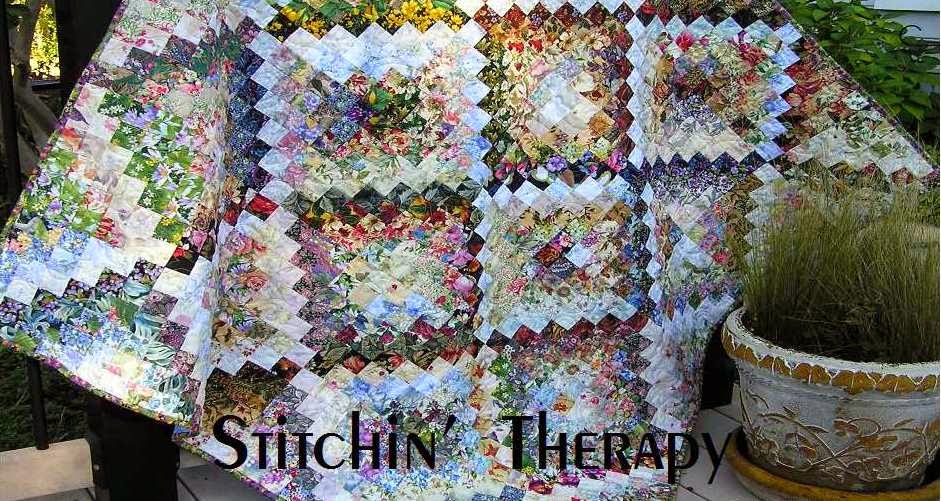I only had about 11 inches of width left over from
the quilt strata. But I sliced it up anyway.
The strata is made up of 4" strips of fabric---sewn in the order you decided on. Use a swatch card....very important to use and refer to.
All seams are pressed in the same direction---towards the bottom. Take care when pressing not to stretch or curve the seam line.
Then the strata is sewn into a tube by sewing the last fabric to the first.
Then you slice up the strata tube into different widths. I will give you a general list of sizes later, but I will be playing around with my own first.
For this example because it was so small, I cut 1", 1 1/2", and 2" strips.

 When I did my first one a few years ago , I followed the directions exactly by the book, and it was more linear, straight line. I think there were 3 or 4 different width cuts for it and they were spread out across the quilt so that the color line was fairly even with only a slight wave. I'm hoping to get a lot more movement in the color line with skinny strips grouped together---so it resembles a bargello. More on that when I get there.
When I did my first one a few years ago , I followed the directions exactly by the book, and it was more linear, straight line. I think there were 3 or 4 different width cuts for it and they were spread out across the quilt so that the color line was fairly even with only a slight wave. I'm hoping to get a lot more movement in the color line with skinny strips grouped together---so it resembles a bargello. More on that when I get there.

the quilt strata. But I sliced it up anyway.
The strata is made up of 4" strips of fabric---sewn in the order you decided on. Use a swatch card....very important to use and refer to.
All seams are pressed in the same direction---towards the bottom. Take care when pressing not to stretch or curve the seam line.
Then the strata is sewn into a tube by sewing the last fabric to the first.
Then you slice up the strata tube into different widths. I will give you a general list of sizes later, but I will be playing around with my own first.
For this example because it was so small, I cut 1", 1 1/2", and 2" strips.

This one is sewn together with the color moving upward instead of down. No reason, I just thought I would see what happened.
What I wanted to show was how the pattern develops and that there are no matching seams on the rows. Each row is cut from the fabric strata made with 4" strips that is sewn into a tube before cutting. When the rows are joined, the fabric matches itself at the midpoint---not at the seam line. Look at the brown. Each row that was added moved up to the midpoint of the previous brown. No seams to match! Yes, I like that very much, and that is why this technique goes so fast.
The second thing to notice is the width of each row is not the same. The skinnier the cut, the faster the pattern moves (up or down). The wider cuts slow it down. Several narrow cuts sewn right together make the pattern move quickly, and produces lots of movement.
The second thing to notice is the width of each row is not the same. The skinnier the cut, the faster the pattern moves (up or down). The wider cuts slow it down. Several narrow cuts sewn right together make the pattern move quickly, and produces lots of movement.
 When I did my first one a few years ago , I followed the directions exactly by the book, and it was more linear, straight line. I think there were 3 or 4 different width cuts for it and they were spread out across the quilt so that the color line was fairly even with only a slight wave. I'm hoping to get a lot more movement in the color line with skinny strips grouped together---so it resembles a bargello. More on that when I get there.
When I did my first one a few years ago , I followed the directions exactly by the book, and it was more linear, straight line. I think there were 3 or 4 different width cuts for it and they were spread out across the quilt so that the color line was fairly even with only a slight wave. I'm hoping to get a lot more movement in the color line with skinny strips grouped together---so it resembles a bargello. More on that when I get there. 
2 comments:
I haven't made a quilt in several years, on a charity crocheting jag at the moment, but that doesn't stop me from visiting to oogle yours! Perhaps it's time to switch to charity quilts!!
I like your blog so much, I've nominated you for The Versatile Blogger Award!
Linda
I think I understood that but I'm woolly-headed again today so may have to read it again when my head clears. Better yet, when I am ready to give it a go!
Congratulations on being nominated for the Versatile Blogger award.
Post a Comment